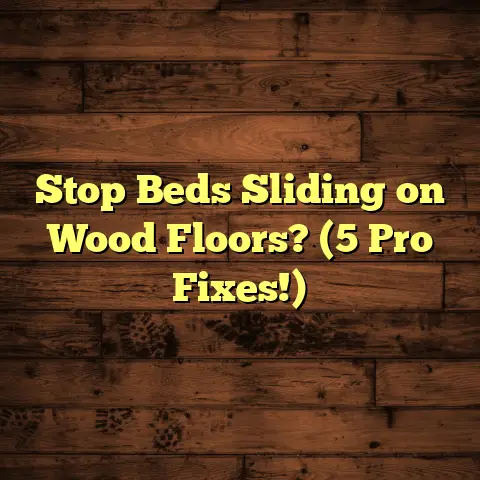Grease Removal On Floors: Pro Secrets! (in 5 Mins!)
Ever watched a cooking show where someone drops a pan of sizzling bacon grease? Or maybe you’ve seen a sitcom character take an unexpected tumble on a slick kitchen floor?
It’s funny on TV, but in real life, grease spills are no joke! I’m here to spill the beans (not grease!) on how to tackle those slippery situations in a flash – like, 5 minutes flash!
Section 1: Understanding Grease and Its Sources
Okay, let’s get down to brass tacks. What is grease, anyway? Essentially, it’s any oily or fatty substance that can cling to surfaces.
Think of it as the sticky stuff that makes your kitchen a hazard zone after a cooking marathon.
Now, where does this menace come from? In the kitchen, cooking is the biggest culprit: splattering oil, bacon grease, sauce spills, and even butter.
But it’s not just the kitchen! Garages can be grease central, thanks to car oil, lubricants, and other automotive fluids.
Even in workshops or industrial spaces, machinery leaks can create a greasy nightmare.
Why should you care about this greasy invasion? Well, besides being unsightly, grease makes floors incredibly slippery. A fall on a greasy floor can lead to serious injuries.
Plus, grease can attract dirt and grime, making your floors look permanently dingy. And, depending on the flooring, grease can actually damage the surface over time.
Section 2: The Importance of Quick Action
Time is of the essence when it comes to grease. I cannot stress this enough! The longer you let grease sit, the harder it becomes to remove.
Think of it like this: fresh grease is a guest you can easily usher out the door. Old, dried grease is a squatter who’s moved in and changed the locks.
I’ve seen floors where grease stains have become virtually permanent because they weren’t addressed quickly. The grease seeps into the pores of the material.
I remember one client who ignored a small grease spill on their hardwood floor for weeks. By the time they called me, the grease had penetrated the wood, leaving a dark, stubborn stain that required professional refinishing.
According to a study by the National Floor Safety Institute, falls are a leading cause of injury in the home. And grease on floors is a major contributor.
In fact, a study published in the “Journal of Safety Research” found that immediate cleanup of spills can reduce the risk of slip-and-fall accidents by up to 60%!
Don’t wait! A little elbow grease (pun intended!) right away can save you a lot of time, money, and potential injuries down the road.
Section 3: Pro Secrets for Quick Grease Removal
Alright, let’s get to the good stuff! I’m sharing my top secrets for banishing grease in just five minutes. Ready to become a grease-fighting ninja?
Subsection 1: Tools and Materials Needed
First, gather your arsenal. Here’s what you’ll need:
- Mops: A regular mop is fine for general cleaning, but a microfiber mop is excellent for grease because it grabs onto the grease.
- Scrub Brushes: Choose a brush with stiff bristles for tile and concrete, but opt for a softer brush for more delicate surfaces like hardwood.
- Towels: Microfiber towels are your best bet. They’re absorbent and won’t leave lint behind.
- Dish Soap: Good old-fashioned dish soap is a surprisingly effective degreaser. Look for a brand that specifically advertises its grease-cutting abilities.
- Baking Soda: This is a natural abrasive that can help lift grease stains. It’s also great for absorbing odors.
- Vinegar: White vinegar is a fantastic all-purpose cleaner and degreaser. Its acidity helps break down grease.
- Commercial Degreasers: For heavy-duty grease, you might need a commercial degreaser. Make sure to choose one that’s safe for your specific flooring type.
Pro Tip: Always test any cleaning solution in an inconspicuous area first to make sure it doesn’t damage or discolor your flooring.
Subsection 2: Step-by-Step Grease Removal Techniques
Now for the main event! Here’s how to tackle grease on different types of flooring in five minutes or less:
For Tile Floors:
- Mix: Combine a tablespoon of dish soap with a gallon of warm water in a bucket.
- Apply: Dip your mop or scrub brush into the soapy water and apply it to the greasy area.
- Scrub: Use a scrub brush to vigorously scrub the grease stain. For stubborn stains, sprinkle a little baking soda on the area before scrubbing.
- Rinse: Rinse the area thoroughly with clean water.
- Dry: Use a clean microfiber towel to dry the floor. This will prevent water spots and ensure that no soapy residue is left behind.
For Hardwood Floors:
- Dampen: Lightly dampen a microfiber cloth with a mixture of warm water and a few drops of dish soap. Don’t soak the cloth. Too much water can damage hardwood.
- Wipe: Gently wipe the greasy area with the damp cloth. Use a circular motion to lift the grease.
- Dry: Immediately dry the area with a clean, dry microfiber towel.
- Vinegar trick: For lingering grease, try wiping the area with a cloth dampened with a solution of equal parts water and vinegar. Again, dry immediately.
For Laminate Floors:
- Vinegar Solution: Mix equal parts white vinegar and water in a spray bottle.
- Spray: Lightly spray the greasy area with the vinegar solution.
- Wipe: Wipe the area with a clean microfiber cloth. Laminate is susceptible to water damage, so don’t let the solution sit for too long.
- Dry: Dry the area with a clean, dry microfiber towel.
For Concrete Floors:
- Commercial Degreaser: Apply a commercial degreaser according to the manufacturer’s instructions. For heavy-duty grease, you might need to let the degreaser sit for a few minutes before scrubbing.
- Scrub: Use a stiff-bristled brush to scrub the greasy area.
- Rinse: Rinse the area thoroughly with water. For large areas, a power washer can be a lifesaver.
- Dry: Allow the concrete to air dry.
Important Note: When using commercial degreasers, always wear gloves and eye protection to protect yourself from harsh chemicals.
Section 4: DIY vs. Professional Help
So, when can you handle grease removal yourself, and when should you call in the pros?
DIY cleaning is usually effective for:
- Small, fresh grease spills.
- Grease on easily cleanable surfaces like tile and laminate.
- Situations where you have the right tools and cleaning agents.
However, there are times when professional help is the best option:
- Large, stubborn grease stains that have been sitting for a while.
- Grease on delicate surfaces like hardwood or natural stone.
- When you’ve tried DIY methods and haven’t had success.
- If you’re dealing with a hazardous substance like motor oil.
I remember one time, a client tried to remove a large grease stain from their marble floor using a harsh abrasive cleaner. They ended up scratching the marble and making the stain even more noticeable!
Sometimes, it’s best to admit defeat and call in the experts. We have the tools, experience, and knowledge to safely and effectively remove grease stains without damaging your floors.
“I’ve seen homeowners try everything from bleach to gasoline to remove grease stains,” says Maria Rodriguez, a professional cleaner with 15 years of experience. “It’s amazing what people will try! But often, they end up making the problem worse. That’s when it’s time to call in the pros.”
Section 5: Pro Tips for Prevention
The best way to deal with grease is to prevent it from happening in the first place! Here are some pro tips to keep your floors grease-free:
- Use Mats: Place mats in high-traffic areas like in front of the stove, sink, and garage entrance. These mats will trap grease and dirt before they can reach your floors.
- Regular Maintenance: Sweep or vacuum your floors regularly to remove loose dirt and debris. This will prevent grease from sticking to the surface.
- Proper Cooking Practices: Use splatter screens when frying food to prevent grease from splattering. Wipe up spills immediately.
- Ventilation: Use your range hood when cooking to vent grease and smoke outside. This will help prevent grease from building up on your kitchen surfaces.
- Protective Coatings: Consider applying a protective coating to your floors. This will create a barrier that prevents grease from penetrating the surface.
There are also some great products on the market that can help maintain clean floors over time. For example, microfiber floor cleaners are excellent for trapping grease and dirt.
You can also find specially formulated floor cleaners that are designed to repel grease and make it easier to clean up spills.
Conclusion: The Grease-Free Future
So, there you have it! My top secrets for quick and effective grease removal. With the right knowledge and tools, anyone can be a “pro” at floor cleaning.
Remember, quick action is key. The sooner you address a grease spill, the easier it will be to remove.
Don’t let grease ruin your floors or create a safety hazard. Follow these tips, and you’ll be well on your way to a grease-free future!
Call to Action:
What are your favorite grease removal tips? Share them in the comments below! Or, if you’ve had a particularly challenging grease stain experience, tell us about it! Let’s learn from each other and create a community of grease-fighting experts!





